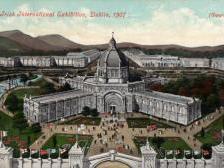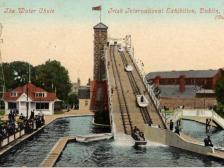The Irish International Exhibition of 1907
Published on 3rd March 2014
 The Irish International Exhibition of 1907 happened because of the vision of one man, the commitment of another and the management skills of a third. Their names are William Dennehy, William Martin Murphy and James Shanks, together with many people who helped in the creation of the Exhibition, they made the Exhibition the sensation of 1907. The purpose of the exhibition was to highlight the Irish industrial endeavour.
The Irish International Exhibition of 1907 happened because of the vision of one man, the commitment of another and the management skills of a third. Their names are William Dennehy, William Martin Murphy and James Shanks, together with many people who helped in the creation of the Exhibition, they made the Exhibition the sensation of 1907. The purpose of the exhibition was to highlight the Irish industrial endeavour.
The Irish Industrial Conference held on 14th April 1903 was when it was decided. A committee was put together and its first task undertaken was to find a site. Due to the opinions of the committee they decided on a site south of the city, as it was more accessible. It was an area that Lord Pembroke has promised to the Pembroke District Council for a public park, the area was 52 acres of rough ground in Ballsbridge lying between the River Dodder, Morehampton Road and Clyde Road.
Their next task was to raise money; in April of 1904 it was decided to open the Guarantee Fund. An address was written and circulated widely; this described the exhibition and the financial support needed along with the steps already taken to secure it. They hired a project manager by the name of James Shanks for an initial period of six months. By September 1905 he had the fund up to £150,178,but it wasn’t until 10th January 1906 that he was able to hand over validly executed guarantees totalling £150,703.
The Exhibition opened on 4th May 1907. The Concert Hall had opened its doors at 10am and had to close at 11:30 as it had filled up. The exhibition was an instant success with 28,150 people going through the turnstiles the following Saturday. An eight to twelve page programme was produced daily giving details of special events of the day and the ever-changing line-up of bands and musical performers.
 There was a section set aside for amusements. The Water Chute, the Helter Skelter, the Crystal Maze, a Shooting Jungle with life-like animals, Rivers of Ireland and a Cinematography. There was an educational sideshow that had an observatory beehive and also an ants’ nest that was illuminated and magnified. There was also Somalian families who were housed in the Somali Village exhibit, they carried out daily tasks and made craft items which they sold.
There was a section set aside for amusements. The Water Chute, the Helter Skelter, the Crystal Maze, a Shooting Jungle with life-like animals, Rivers of Ireland and a Cinematography. There was an educational sideshow that had an observatory beehive and also an ants’ nest that was illuminated and magnified. There was also Somalian families who were housed in the Somali Village exhibit, they carried out daily tasks and made craft items which they sold.
The closing ceremony was held at 4pm on Saturday 9th November in the Concert Hall with the Lord and Lady Aberdeen in attendance. The Marquess of Ormonde read an address to the throng, when finished Barton M’Guckin took over with a musical programme assisted by 800 performers, thus closing the ceremony.
Although the Exhibition had closed, there were more committee meetings held after. They sold off the building materials over the next eighteen months, but a problem arose when the Pembroke Township Council demanded £11,000, as the exhibition was supposed to vacate by 29th June 1908, but hadn’t finished their work by then. Eventually the grounds were enclosed and railings erected around park with a road through it opened to the public and it is now named Herbert Park. The only reminder of the Exhibition today is the pond used for the water chute, still popular with walkers and duck-feeders.
This image gallery was created by Louise Walker while doing an internship at Dublin City Library and Archive. She is a student at Dún Laoghaire Further Education Institute doing an Art, Culture & History course.
Search the library catalogue for publications relating to the The Irish International Exhibition. Find out more also about the wide range of material that forms part of the Dublin and Irish Collections in Dublin City Public Libraries.
View The Irish International Exhibition of 1907 image gallery.
Further Resources
Dublin City Libraries has a wide range of sources on the social, political, and cultural history of Dublin, some of which are available online and some through the Dublin City Libraries network.
The Reading Room, Dublin City Library and Archive, Pearse Street holds a wealth of material on the history of Dublin, including books, pamphlets, journals, street directories, and almanacs.
The following online resources can be accessed free of charge at your local library. Ask library staff for information and assistance.
- DRI - Digital Repository of Ireland is a national digital repository for Ireland’s humanities, social sciences, and cultural heritage data. Here you will find select digital collections of Dublin City Library and Archive. Highlights of the collection include the Fáilte Ireland Photographic Collection, the Jacobs Biscuit Factory Photographic Archive, Wide Street Commission and the Royal Dublin Fusiliers Association Archive.
- Irish Times Digital Archive: This online archive service gives access to contemporary editions of the Irish Times from the mid-nineteenth century until the present.
- Irish Newspaper Archive: This online archive service gives access to contemporary editions of the Irish Independent and a range of other newspapers.
- The Ireland-JSTOR Collection: This online archive of academic articles can also be accessed free of charge at your local library.
For further reading, consult the Library Catalogue.